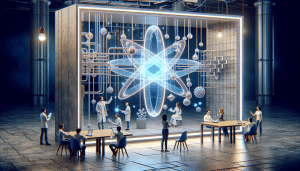Unlock the Influence of Artificial Intelligence in Daily Life
Aiden Foster September 2, 2025
Curious about the true reach of artificial intelligence? This guide reveals how AI technologies are transforming work, health, education, and everyday problem-solving. Explore the impact, challenges, and real-world uses shaping your world, with practical details on how AI integrates into the fabric of daily life.
The Role of Artificial Intelligence in Everyday Tasks
Artificial intelligence underpins many routine activities, offering seamless convenience in unexpected places. Smart assistants manage reminders, home automation systems adjust lighting based on your habits, and personalized recommendations on streaming services demonstrate how machine learning permeates ordinary experiences. The prevalence of AI in these daily applications often goes unnoticed, yet it quietly shapes decisions and preferences by analyzing patterns in user behavior. These intelligent systems are designed to anticipate needs and streamline workflows, reducing repetitive tasks and improving efficiency around the house and workplace.
Beyond smart homes and voice assistants, AI powers features in commonly used devices. Smartphones leverage natural language processing for real-time language translation or predictive text, while autonomous vehicles use visual recognition to interpret surroundings. Even social media platforms rely on AI algorithms to customize news feeds, promote safety, and flag inappropriate content. These tools use robust data sets and machine learning models to deliver more personalized user experiences, emphasizing relevance and convenience in interactions, entertainment, and communication.
AI’s influence extends further to scheduling, travel, and shopping. Navigation systems use predictive algorithms for traffic, helping save time and fuel. E-commerce recommendations adapt in real-time as shopping habits shift. Online customer support increasingly relies on conversational AI that resolves routine inquiries and escalates more complex questions to human agents. By becoming embedded in so many aspects of modern life, artificial intelligence is woven invisibly into the fabric of daily routines, offering both practical improvements and avenues for ongoing personal optimization.
AI in Healthcare: Transforming Diagnosis and Patient Care
Artificial intelligence now plays an influential role in supporting clinicians and patients. Diagnostic tools use AI-powered image recognition to identify early signs of diseases through X-rays, MRIs, and CT scans. By analyzing patterns against vast medical databases, these systems can flag potential abnormalities with a precision that complements human expertise. Such advances are helping healthcare professionals detect conditions at earlier stages and tailor treatment strategies based on extensive real-world evidence and predictive risk models (Source: https://medlineplus.gov/artificialintelligence.html).
In day-to-day care, AI is enabling personalized medicine. Algorithms assess genetic information, lifestyle factors, and historical health records to suggest individualized interventions or warn about medication side effects. Virtual nursing assistants monitor recovery remotely, answer common questions, and notify caregivers of potential complications before they escalate. These innovations are not only improving outcomes but also expanding access to reliable healthcare information for a broader population, making patient-centered care more reachable at home and on the go.
The integration of artificial intelligence in health technology carries both promise and important ethical considerations. While AI can lead to more accurate diagnoses and faster results, transparency and privacy are critical. Responsible deployment involves rigorous validation and oversight, as well as educational initiatives for both providers and patients to understand how AI-derived suggestions support, rather than replace, trained medical judgment. As research continues, ongoing collaboration between engineers, clinicians, and policymakers will guide the evolution of trustworthy health-centric AI.
The Impact of AI on Education and Learning Experiences
Education systems are evolving quickly with the adoption of artificial intelligence. AI tools are now personalizing learning paths for students, adapting lesson content to each individual’s pace, strengths, and areas needing improvement. Intelligent tutoring systems offer real-time feedback, supporting both educators and learners in optimizing how new knowledge is absorbed. These systems leverage vast educational resources and advanced analytics, fostering more engaging and effective ways to master complex subjects (Source: https://ed.stanford.edu/news/ai-education).
AI-driven platforms facilitate automatic grading, track progress, and alert teachers to emerging challenges. This automation enables teachers to devote more attention to mentoring and creativity rather than repetitive administrative work. Online courses powered by machine learning can adapt in real-time, providing additional resources or exercises when learners struggle. AI translation tools also bridge language barriers, offering access to educational materials worldwide and supporting greater inclusivity, especially for students in remote or underserved regions.
As AI becomes more embedded in classrooms and remote settings, the relationship between technology and traditional teaching methods continues to evolve. While the potential to increase student engagement and access is significant, educators and policymakers emphasize the need for thoughtful design. Data privacy, algorithmic fairness, and transparency remain paramount. By integrating ethical considerations and ongoing research, institutions ensure AI complements, rather than disrupts, the human element at the heart of meaningful learning.
Workplace Automation and the Rise of Smart Industries
The workplace is experiencing a major transformation fueled by artificial intelligence and automation technologies. Businesses of all sizes use AI to optimize logistics, analyze big data, and predict customer demand. Robotic process automation streamlines tasks once performed by hand, such as processing invoices, managing inventory, and responding to service inquiries. This automation frees up employees to focus on creative problem-solving and higher-level decision-making, supporting a more dynamic work environment (Source: https://www.brookings.edu/articles/what-jobs-are-affected-by-ai/).
AI’s predictive algorithms can recommend optimal pricing or supply chain routes, minimizing unnecessary spending and disruptions. In industries ranging from finance to agriculture, machine learning uncovers hidden patterns that guide resource planning and risk mitigation. In manufacturing, smart sensors track equipment health and predict maintenance needs before breakdowns occur. Organizations leveraging these insights respond to shifts more quickly, building resiliency and enabling scalable growth in competitive sectors.
The impact of artificial intelligence in the workplace sparks essential debate around workforce skills, retraining, and the future of employment. By automating routine or hazardous roles, AI presents opportunities to reduce workplace injuries and create safer environments. However, it also highlights the need for continuous learning programs that help workers acquire skills aligned with emerging technology. Collaboration between industries, educators, and governments shapes strategies that ensure economic opportunity remains broad and accessible in an AI-enhanced future.
AI Ethics, Data Privacy, and the Importance of Trust
Widespread integration of artificial intelligence raises pressing questions about ethics and data security. AI systems depend upon large volumes of personal and behavioral data to deliver accurate predictions. Ensuring transparency in how this data is used, stored, and shared is crucial for building and maintaining public trust. Organizations adopting AI must implement robust privacy standards, including consent and anonymization, to protect individual rights and address concerns about surveillance or bias (Source: https://www.nist.gov/artificial-intelligence).
Bias in AI algorithms can inadvertently reinforce existing inequalities if not properly monitored. Ethical frameworks and independent audits are essential to identify unintended discrimination or unfair outcomes. Initiatives to make AI development more inclusive—by ensuring diverse data sets and multidisciplinary oversight—also support fairer results. Users increasingly demand that artificial intelligence decisions remain explainable, prompting researchers to explore new tools for interpreting complex machine learning models and maintaining accountability in automated decisions.
Trust in AI-driven systems is built over time through transparency, education, and regulation. Clear communication around how artificial intelligence makes decisions—along with avenues for recourse in case of error—helps align innovation with societal expectations. As guidelines and laws evolve, stakeholders are called to participate in shaping standards that safeguard both technological advancement and the values fundamental to open, democratic societies. This ongoing dialogue informs responsible AI use and continuous improvement in ethical practices.
Looking Ahead: Future Directions of Artificial Intelligence
The horizon for artificial intelligence is vast, spanning from advanced robotics to creative endeavors. On the research frontier, AI is being integrated with neuroscience, environmental modeling, and climate science to unlock new understanding and solutions. Potential applications include climate forecasting, resource management, and adaptive learning systems designed to respond to urgent societal challenges. As these innovations progress, the boundaries between digital and physical realities continue to blur, expanding opportunities in ways previously imagined only in science fiction.
In creative industries, AI tools now generate art, compose music, and even write code—sometimes in partnership with human creators. This trend introduces questions about authorship and originality but also presents new forms of collaboration and expression. The accessibility of these platforms allows individuals and small teams to experiment with advanced techniques, leveling the creative playing field and opening up unexplored possibilities for design, media, and storytelling.
The future of AI depends on robust investments in research, education, and public engagement. Empowering society to harness the benefits—while navigating challenges—demands ongoing dialogue across disciplines, cultures, and sectors. As artificial intelligence evolves, it offers both profound promise and responsibility. By working together, innovation and inclusivity can move forward hand in hand, ensuring the technology serves broad needs and shared values.
References
1. National Library of Medicine. (n.d.). Artificial Intelligence in Medicine. Retrieved from https://medlineplus.gov/artificialintelligence.html
2. Stanford Graduate School of Education. (n.d.). AI in Education: Opportunities and Challenges. Retrieved from https://ed.stanford.edu/news/ai-education
3. Brookings Institution. (n.d.). What Jobs Are Affected by AI? Retrieved from https://www.brookings.edu/articles/what-jobs-are-affected-by-ai/
4. National Institute of Standards and Technology. (n.d.). Artificial Intelligence. Retrieved from https://www.nist.gov/artificial-intelligence
5. Pew Research Center. (n.d.). Public Attitudes Toward Artificial Intelligence. Retrieved from https://www.pewresearch.org/internet/2022/08/05/public-attitudes-toward-artificial-intelligence/
6. MIT News. (n.d.). The Impact of Artificial Intelligence Across Industries. Retrieved from https://news.mit.edu/2023/impact-artificial-intelligence-across-industries-0111








